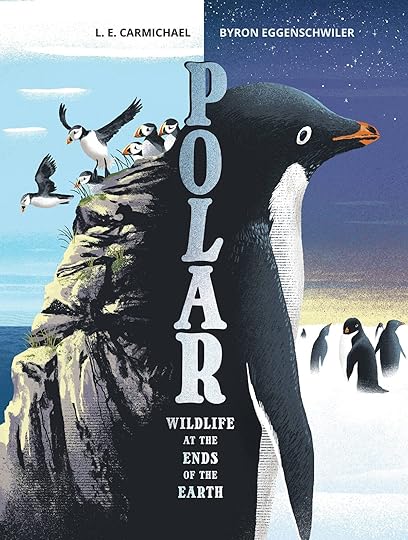L.E. Carmichael's Blog, page 11
October 3, 2022
Museum in the Classroom: The Pleistocene Extinction Teaching Kits

A mastodon molar is AS BIG AS MY HEAD, y’all.
Did you have a dinosaur phase when you were a kid? I did. I was in the second grade, and I was obsessed. I pored over library books, memorizing five-syllable names and amazing the adults with my stockpile of bizarre dino facts (I still do that). I liked the armoured species best, because they were just so weird.
And then my parents took me to the Royal Tyrrell Museum to see real fossils.
Mind. Blown.
Looking back, I can see how these early experiences helped spark my life-long obsession, not just with dinosaurs, but with all life on Earth. But not every child has opportunities to visit natural history museums, either with their families or on school field trips. That’s why, when Dr. Lynda Colgan asked me to write the teacher’s guides for her Learning with Palaeontology project, I jumped at the chance.
(Also, I’m pretty sure that all children’s science writers are legally-obligated to write about dinosaurs at least once in their careers, so box checked!)
As with most of Lynda’s ideas, this one was both simple and profound. First, we’d get some great big boxes. Next, we’d fill them with museum quality casts of real fossils, providing teacher’s guides that provided the latest scientific knowledge about the species, while focusing on inquiry and hands-on learning. And then, we’d make the kits available to teachers for free.

And giant beavers? They were as big as black bears. I mean, how cool is THAT?
The first two Kits, on the Pleistocene Extinction, are now available to borrow. Teacher-friends, here’s what you need to know:
Features of the KitsFossil casts of mammals that lived in Canada during the PleistoceneSupporting materials such as magnifying glasses, graphs, and chartsTeacher’s Guide containingALL the information needed to teach core conceptsSuggestions for hands-on learning and independent inquiryGlossary, further reading lists, and bibliography of sourcesContent vetted by experts in palaeontology, education, science communication, and Indigenous issuesCore Concepts and SkillsJunior Edition – Best for Grades 4-7
HabitatEvolution and adaptationsBiodiversity and classification systemsFood chains and energy pyramidsCompetition and predator/prey interactionsClimate changeExtinctionSenior Edition – Best for Grades 8-12
Habitat and geographic rangeEvolution and adaptationsCompetition and predator/prey interactionsTrophic cascadesHeredity and ancient DNAClimate changeExtinctionDe-extinction: biotechnology and bioethicsCorrelation vs. causation
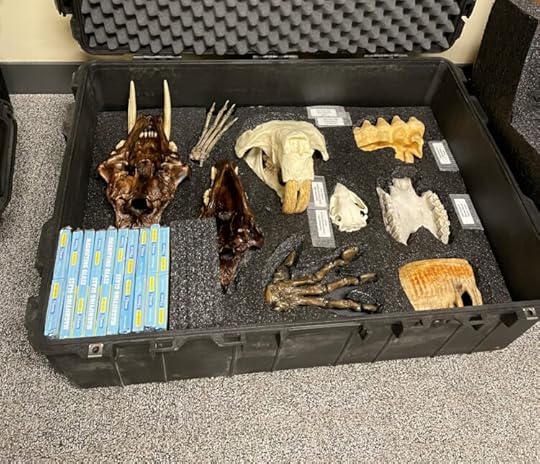 At both levels, students will:
At both levels, students will:
Are you in Ontario? You’re in luck! Head on over to the Queen’s University Education Library catalogue and place a hold on a physical kit. The cases are on wheels, but they weigh about 40 pounds, so I recommend bringing a friend and a vehicle with a big trunk.
Not in Ontario? Don’t worry, we have got you covered. Each Kit is also available in a digital edition, complete with 3D scans of the fossils that you can manipulate from your web browser. Direct links are here:
Junior/Elementary Level
The Pleistocene: Using Ice Age Mammals to Explore Climate, Habitat, and Extinction
Senior/High School Level
Conservation Palaeontology: Using Ice Age Mammals to Explore Climate Change and Extinction
Again, these resources are available to Canadian teachers absolutely free. I field tested them at some student workshops during Science Rendezvous in May, and I can guarantee your kids will be spellbound. I was beyond delighted at the level of critical thinking and curiosity my groups displayed while interacting with the fossils, and I can’t wait to hear similar stories from classrooms across the country.
I also cannot wait to launch the new Kits we’ve been developing this year. Stay tuned, and keep exploring!
The Learning With Palaeontology Project is supported by:



with graphic design by:

September 19, 2022
Science Literacy Week! And The Cover of My New Book It’s So Pretty I Can’t Even!!
It’s Science Literacy Week! And while I cannot even believe it’s the middle of September already, I am always so excited when SLW rolls around. Because SLW is the week when we celebrate science, and what science is, and how to think about science, and maybe even read some really awesome science books.
Speaking of which…
MY NEW CHILDREN’S SCIENCE BOOK IS NOW LISTED ON AMAZON AND THERE ARE NOT ENOUGH CAPS OR EXCLAMATION POINTS IN THE WORLD TO CONVEY MY EXCITEMENT, PEOPLE!!!!
POLAR is a follow up to The Boreal Forest, which was also published by Kids Can Press. It’s illustrated by Byron Eggenschwiler, and his artwork is absolutely phenomenal – every single interior spread is just as stunning as this jaw-dropping cover. The book comes out May 2, 2023, but you can pre-order your copy through Amazon or – even better – your local indie bookstore.
Did I mention that children love nonfiction? It’s true – actual scientific research shows that, when given a choice between storybooks and nonfiction, a majority of young kids will pick a nonfiction title on a subject they are interested in. Those preferences hold for older kids too, many of whom read fiction and nonfiction equally, despite the well-meaning adults that keep trying to steer them towards novels. One of the best things I’ve ever read in an academic journal article is this quote about nonfiction from an actual 4th grader:
“Reading a story is for adventure, just let your imagination go wild, to have fun. Science texts tell you more information, what happened in the past, or in the present, teach you more stuff that you didn’t get from the storybooks, improve your mind… You need both to live on the world. Without stories you would have no culture and feelings. Without information, you’d be a dope.”
This kid is 100% my people, y’all. This Science Literacy Week, take his word for it, and share some nonfiction with the youngsters in your life. Here are ten ways to do that:
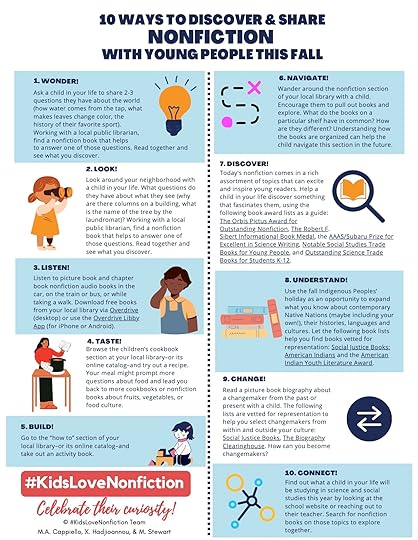
In other exciting news, I was recently a guest on Popular Podagogy! It was a delightful 30 minutes in which I got totally geeky over science literacy with science teacher and Queen’s professor Chris Carlton. Chris is also my people (and now his podcast support crew are too). You can listen to the episode here.
Go forth and get sciencey, my friends! And don’t forget to visit the official Science Literacy Week website for tips on fun, FREE science activities happening near you.
September 9, 2022
Deborah Kerbel: Get Thee to a Crit Group!
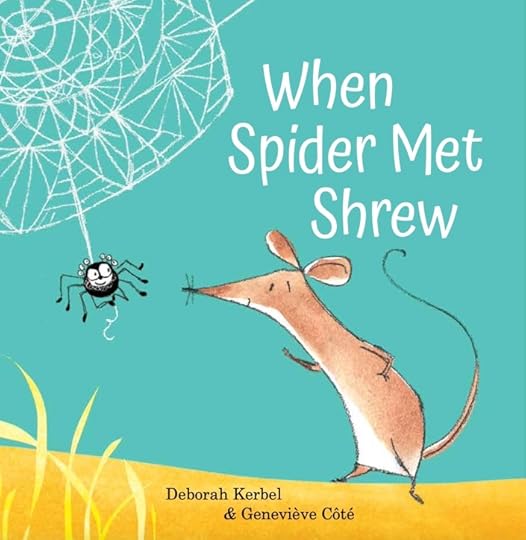 Welcome to Cantastic Authorpalooza, featuring posts by and about great Canadian children’s book creators! Today’s guest:
Deborah Kerbel
. Take it away, Deborah!
Welcome to Cantastic Authorpalooza, featuring posts by and about great Canadian children’s book creators! Today’s guest:
Deborah Kerbel
. Take it away, Deborah!
My newest picture book, WHEN SPIDER MET SHREW (illustrated by Genevieve Cote and published by Groundwood Books), is about a group of unlikely creatures – Spider, Shrew, Bat, Possum, Dog, and Pony – who find friendship, compassion, and community in each other. Although the story was inspired by two viral videos about sweet and quirky animal pals, the heart of the book — the message that helping someone in need can sometimes fulfill needs of our own — calls to mind something a little closer to home. Specifically, my crit group.
Whenever I’m asked to offer writing advice to hopeful up-and-coming authors, after “read, read, and then read some more” my #1 suggestion is “find yourself a critique group”. Why? In addition to friendship and support, you’re guaranteed to evolve into a much better writer. That’s because giving feedback is more useful to your creative growth than receiving it. Those of you already in a crit-group of your own are likely nodding your head in agreement at this point. And those of you who aren’t, please take a second and read that last part again so it sticks.
Giving feedback is more useful to your creative growth than receiving it.
How is this magic possible, you ask? How can helping a fellow-creative in need end up fulfilling creative needs of our own? How can giving be more beneficial than receiving? Simple. Because by picking apart someone else’s writing, considering its strengths and weaknesses, and analyzing what works, what doesn’t, and why, you’ll gain practical, hands-on tools and learn oodles about the craft of writing.
Case in point: yours truly.
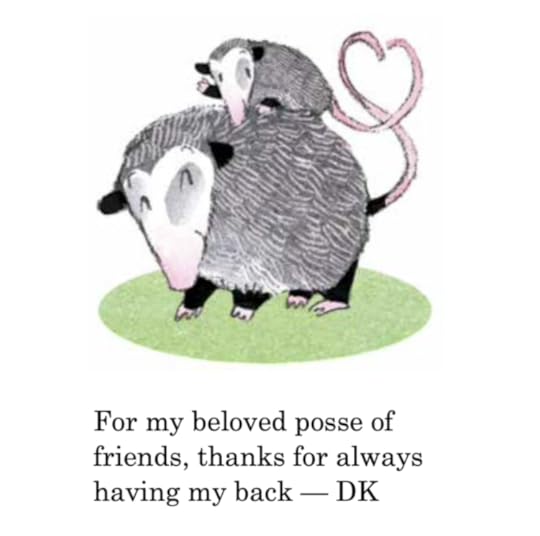 When I first started on my publishing journey, I was lucky enough to join up with a small group of like-minded kidlit authors, all of us looking for feedback, friendship, and advice in this roller-coaster-ride of a business. Over the years, we’ve stuck together – sharing manuscripts, ideas, publishing experiences, milestones, and immeasurable amounts of laughter, tears, (and sometimes champagne). Although we all started out at different stages in our publishing journeys, we’ve grown together as creators – celebrating each other’s successes along the way. I would never have published so many titles at this point in my career (going on thirty books now) if it weren’t for my beloved, wise, generous, and trusted critique partners. And the cherry on top? Every time one of our shared crit-group manuscripts makes it to publication, we celebrate as if it was our own. (Cue the proud book-auntie feels!)
When I first started on my publishing journey, I was lucky enough to join up with a small group of like-minded kidlit authors, all of us looking for feedback, friendship, and advice in this roller-coaster-ride of a business. Over the years, we’ve stuck together – sharing manuscripts, ideas, publishing experiences, milestones, and immeasurable amounts of laughter, tears, (and sometimes champagne). Although we all started out at different stages in our publishing journeys, we’ve grown together as creators – celebrating each other’s successes along the way. I would never have published so many titles at this point in my career (going on thirty books now) if it weren’t for my beloved, wise, generous, and trusted critique partners. And the cherry on top? Every time one of our shared crit-group manuscripts makes it to publication, we celebrate as if it was our own. (Cue the proud book-auntie feels!)
As the saying goes, “Friends are family you get to choose.” I’m forever grateful for my priceless critique-family – this group of unique creatives, with whom I’ve found friendship, compassion, and community. Just like Spider, Shrew, and the rest of their sweet and quirky animal pals.
Lindsey here: Deborah is bang on – you will learn a lot more about writing by giving feedback than getting it. It’s easier to be objective about someone else’s writing, so critiquing helps you build critical thinking skills that, eventually, you’ll be able to apply to your own work. Trust us.
And to learn more about Deborah and her books, be sure to visit her website.
August 21, 2022
Jurassic World: Less Dominion, More Extinction
I vividly remember going to see Jurassic Park (1993) in the theatre. It was me and two of my besties, on the edge of our seats… at least until Kelsey and I glanced over at Julie-Ann and she wasn’t there.
Julie-Ann claims she’d dropped her Smarties box and just had to go find it during a particularly tense sequence of the film. All we know for sure is that Kelsey and I had exactly the same thought in that moment: the dinosaurs got Julie-Ann!!
It was THE BEST. And it’s still one of the best science fiction films I’ve ever seen, because it blends heart-stopping action with ideas and ethics and stunning-for-the-time visuals and performances that capture the little-kid wonder and heart-stopping terror of humans encountering actual dinosaurs. Not to mention Dr. Ellie Sattler, who is still one of my favourite female characters in all of film. This woman is a badass in ALL of the ways:
At least, she was.
That’s right, I went to see Jurassic World Dominion. I know, I know. Every Jurassic Park movie since the first one has completely failed to capture the magic of the original, and believe me, having seen them all, my expectations were… not high. But it’s summer, and there’s still a pandemic on, despite what people seem to believe, and the drive in theatre is a COVID-friendly activity that Tech Support and I have looked forward to every summer since we moved to a latitude where it’s both warm enough and dark enough at a reasonable hour to go. And we deliberately choose ridiculous monster movies, in part because that’s drive in tradition, and in other part because half the fun of the drive in is getting to make fun of the movie without disturbing everyone else who turned up to watch it.
So yes, I expected it to be bad. I just didn’t expect it to reach quite such epic levels of badness.
In all fairness, it was pretty exciting to see that the special effects team had updated the dinos to be more in line with current scientific thought – a delightfully large number of them had feathers. And finally, FINALLY, they managed to get the dinosaurs off the island (a thing which happens at the end of The Book That Started It All). But Dominion is the dying gasp of a franchise that really deserves to go extinct. And the cameos of heroes past couldn’t save it; rather, they added to the soulless travesty of the whole thing. Case in point, Dr. Wu, who just never, never learns. And Dr. Sattler. Oh, Dr. Sattler. She’s no longer a badass with both brains and brawn, who gets it done while the dudes stand around in shock. She’s every blonde woman in every monster movie – there for the scream.
Even more disappointing? Not one dinosaur ate Chris Pratt.
If you haven’t already seen this one, you can safely skip it. Instead, watch my favourite drive-in monster movie – the genuinely tense and claustrophobic Crawl. Way less budget, way more tension.
August 5, 2022
Karen Autio: I Can, Too! – Book Highlights Adaptive Inventions That Allow Inclusion
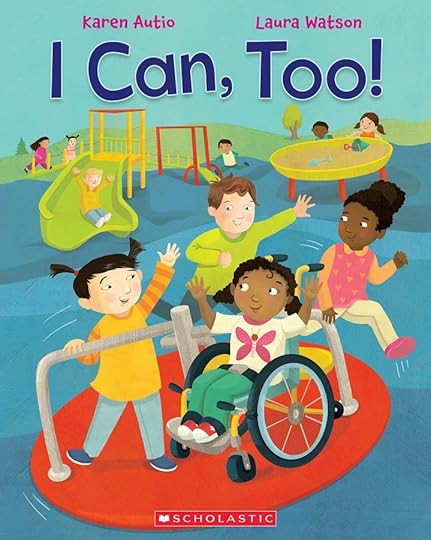 Welcome to Cantastic Authorpalooza, featuring posts by and about great Canadian children’s book creators! Today’s guest:
Karen Autio
. Take it away, Karen!
Welcome to Cantastic Authorpalooza, featuring posts by and about great Canadian children’s book creators! Today’s guest:
Karen Autio
. Take it away, Karen!
My daughter opened my eyes and heart to the world of disabilities. Annaliis was born with spina bifida and used a wheelchair from preschool onward. It was a great joy to see kids welcome and fully include her in their friendship circles. Because of my daughter, I’m keenly interested in increasing disability awareness, access, inclusion, and respect.
Children are naturally curious about disabilities. I wanted to write a story to introduce young children to different ways of getting around. A story to help them understand mobility equipment used by people of all ages. A story that could be a springboard for conversations.
The first inklings of I Can, Too! emerged from my writer’s brain in 2007 in the form of a picture book outline. As I reflected on Annaliis’s experiences with adaptive equipment growing up, I could see how the right invention made all the difference for freedom and friendship. I’m constantly amazed by how creative inventors are in designing devices to make activities accessible and inclusive.

Annaliis sit-skis on Mount Hood outside of Portland, Oregon, with a group from Shriners Children’s Portland in 1995. Photo source: Will Autio
Yes, my outline showed many mobility devices, but where was the story? I pondered but couldn’t see how to shape it until after taking several picture-book writing workshops. In 2017, thinking about Annaliis’s adventurous nature, I re-visioned the idea and the first draft of I Can, Too! was born (even with that title!).
In the story, I purposely did not label the main character’s disability, wanting Kayla to represent as many children as possible who use wheelchairs. Kayla is out and about, active in her community, simply demonstrating a different way of doing things.

A child tries adaptive paddle-boarding on Westwood Lake, Nanaimo, B.C., at an outdoor play day hosted by the Nanaimo Child Development Centre in 2019. Photo source:
https://www.vancouverislandfreedaily.com/community/adaptable-play-day-giving-special-needs-kids-rare-chance-to-play-outdoors/
While adaptive equipment works well to remove physical barriers, it’s people like Piper in the story who are invaluable for breaking down social barriers. My hope is that I Can, Too! will encourage kids (and adults) to say hi when they meet someone different from themselves and start developing a friendship. May this story help children thrive, both those with disabilities and those who will grow by getting to know these resilient, determined children.
When you read the dedication in my book, you’ll learn it’s in memory of Annaliis. She loved that I was working on this story. Annaliis was my biggest book promoter, and I wish she could be here to celebrate it with us. Wait … what’s that sound? I think I can hear her cheering from heaven!
Having raised a child with disabilities, I try my best to be an ally for people with disabilities. Recently I learned about Julia’s Junction, the first all-abilities playground in West Kelowna, B.C., coming in 2023. It will be fully accessible for children and caregivers who use mobility equipment.
I believe inclusive playgrounds are so integral for all children to grow, learn, and connect to develop friendships that I’m donating a portion of my royalties for I Can, Too! and its French translation Moi aussi, je peux! to Julia’s Junction.

Plan for Julia’s Junction, a fully inclusive play space. Photo source: https://www.facebook.com/juliasjunction/
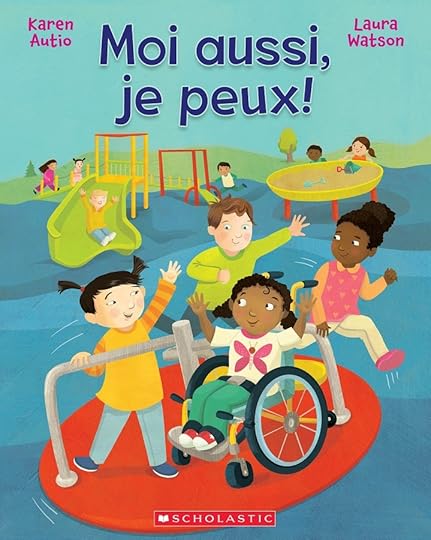
I Can, Too! and Moi aussi, je peux! (releasing October 4, 2022) are illustrated by Laura Watson, published by Scholastic Canada, and geared for kids ages 3-7.
Karen Autio lives in Kelowna, B.C. She is the author of eight books for children and a sensitivity reader for disability awareness.
July 22, 2022
One More Angel in Kitty Heaven

Baby Sas. I mean, those toes, this face, can you even?
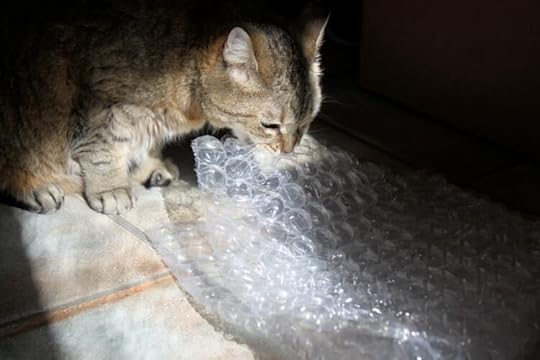 Sasquatch celebrated her 20th birthday on May 30. On June 23, we sent her to kitty heaven. She had arthritis and kidney failure and took more medications than I do. But she was as happy and snuggly as a kitten until she… wasn’t. And we couldn’t watch her suffer just because we didn’t want to suffer.
Sasquatch celebrated her 20th birthday on May 30. On June 23, we sent her to kitty heaven. She had arthritis and kidney failure and took more medications than I do. But she was as happy and snuggly as a kitten until she… wasn’t. And we couldn’t watch her suffer just because we didn’t want to suffer.
So we did the right thing. And then we cried.
I’m still crying, off and on. The first time I made the bed without turning down the corner of the blankets on the end where she used to sleep, I went through six tissues. The first time I pushed my desk chair over to the accessibility stairs Tech Support built so she could safely climb into it? Six more. Now I’m deliberately breaking those patterns–leaving doors open into rooms where she wasn’t allowed to go. Dropping a piece of bubble wrap on the floor without worrying that she’d murder it and get a bowel obstruction. Sasquatch loved to pop bubbles with her teeth.
I’m still convinced I’m catching sight of her out of the corner of my eye. That comes from being hyperaware of her location over the last couple years–that cat LOVED to sneak up right behind you, and with her gimpy legs, she couldn’t get out of the way of clumsy human feet. She also had stealth mode: she could blend into our living room carpet and practically disappear. We never understood how, because the carpet is pink. Fortunately, Sas had developed the habit of meowing to announce herself when she saw us coming.
Losing our fur baby is much harder this time. When her full sister, Jagular, went to kitty heaven, we still had Sasquatch. And Sasquatch got all of the love that had formerly been split between the two of them. Now, it’s just me and Tech Support… and when he’s on the road, just me. He’s on the road now, in fact–his first overnight trip since. And the house is very, very quiet with only one heartbeat in it. I’m keeping busy and trying not to judge myself for how much more I’m talking out loud, to absolutely no one. Hearing my own voice makes the space less lonely.
My right leg is especially lonely. That’s the leg that Sasquatch slept on every night, during TV time. She’d climb the accessibility staircase (we had them in every room), put her two front feet into the hole in my criss-cross-applesauce, and FLUMP against my right hip. And yes, it had to be the right leg. The one time I tried to sit on the other side of the couch, offering my left leg for snuggles, she was NOT HAVING IT. We never tried that experiment again.
[image error]

Snuggle selfie
I loved the way she used tip her head back so she could look at me and purr. She had the funniest little purr–rusty and staccato, like a coffee percolator. And I loved her pointy little teeth, even if they did dig into my thigh. In her later years, she’d sometimes sleep so hard, she’d leave a tiny little drool patch on my pants. And if you left the room while she was napping, she had to find you as soon as she woke up. Sassy loved to be in the room where it happens.
She slept under sun-warmed blankets, in the “easy bake kitty oven,” until she got so hot she panted. She could never be warm enough. And I think she was secretly a Winchester–she was convinced there were monsters in the basement that she needed to hunt for us. She was a championship moth hunter–no crunchy bug could escape her oversized paws.
I miss her. My only consolation is that Sasquatch and Jagular are together again, because they loved each other almost as much as we loved them.
Rest in peace, Octopuss. Rest in peace.
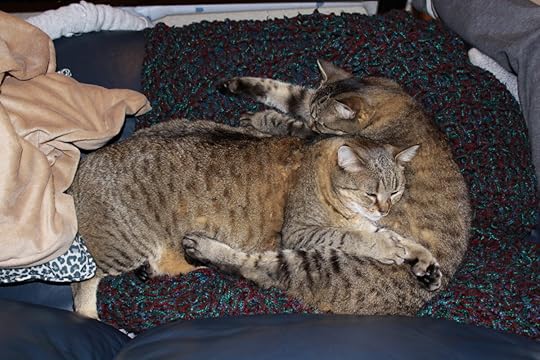
July 8, 2022
Joyce Grant: Can You Believe It?
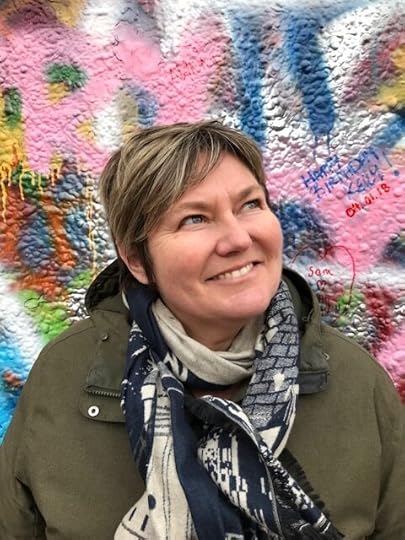 Welcome to Cantastic Authorpalooza, featuring posts by and about great Canadian children’s book creators! Today’s guest: Joyce Grant
. Take it away, Joyce!
Welcome to Cantastic Authorpalooza, featuring posts by and about great Canadian children’s book creators! Today’s guest: Joyce Grant
. Take it away, Joyce!
Can You Believe It? How to Spot Fake News and Find the Facts is my sixth book—my first non-fiction.
I’ve been talking to students about the news since 2010, when I created TeachingKidsNews.com with educator Jon Tilly. Over the years, the questions from students began shifting a bit—they started asking me how to tell if something online is fake. Teachers and parents wanted to know as well.
When I started doing research about it six or seven years ago, fake news-spotting meant looking for wonky URLs and typos in articles and scanning About pages. But as misinformation evolved and got more sophisticated, spotting it became more about critical thinking. Investigating sources and fostering kids’ “something-just-feels-off” intuition.
At first, I was intimidated at the thought of condensing years of research to fit just 56 illustrated pages. I had interviews and discussions with so many people as I was developing the book. A researcher at Stanford University, media literacy and kidlit experts, journalists and parents and kids. The hard part about boiling a lot of information down is that you have to maintain the depth of content. You do that by killing off your darlings—recognizing what’s not relevant (as much as you may want it in there) and what could be said more simply, with fewer words.
I’m very grateful to my editor at Kids Can Press, Kathleen Keenan—I call her the “structure queen.” She suggested a framework that takes the reader on a journey from learning what fake news is and why it’s bad, to seeing how real journalism is m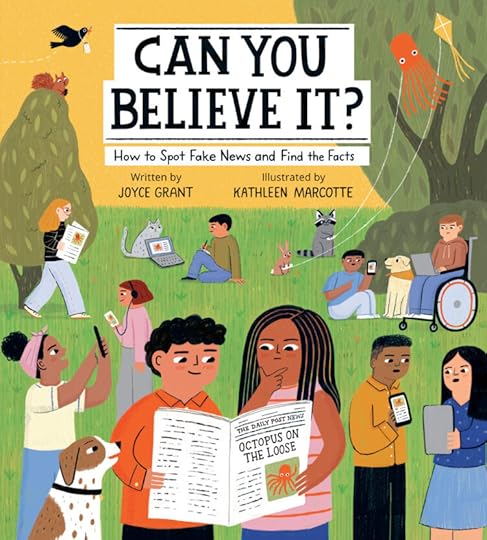 ade and then to how to investigate suspicious posts and videos. That structure gave me room to really have fun with the copy, to add lots of little activities and to introduce nuance, which I think gives a book more depth.
ade and then to how to investigate suspicious posts and videos. That structure gave me room to really have fun with the copy, to add lots of little activities and to introduce nuance, which I think gives a book more depth.
One of the things I’m especially happy about is that the illustrations and scenarios include a wide diversity of kids. We wanted the book to reflect its readers. The illustrator, Kathleen Marcotte, is amazing. It’s hard to believe this is her debut children’s book. Not only did she do an incredible job with the illustrations but she added little humorous moments as well. On one double-page spread there’s a “dinosaur parade” and a girl is tweeting that dinosaurs are back. Meanwhile, the reader can see that the dinosaurs are actually made of cardboard. Kathleen made those teachable moments funny.
The book has lots of names in it, in article by-lines, photo captions and activities. I had a great time dropping the names of my neighbours, friends’ kids and relatives throughout the book. There was a bit of an oopsie that I made, which I’ll know for next time: in a couple of spots, I used the names of three siblings. Later, I cut a couple of scenes and of course one of the names went as well. I had to tell a couple of kids, “your name was in there, I promise—but the section got cut.” They understood, though. And I’ll just use those names in my next book, lol!
And I’m definitely hoping there will be a next one. I think I have a solid concept for another book after this one. It’s still in the planning stages but I’m excited about it. Of course, it takes about three years from contract to shelf, and when you’re writing about technology you have to be careful that it doesn’t change so drastically that the information is no longer relevant by the time the book is published. But I learned a lot of lessons from this book, and from my editor, so it should be easier next time, right? Right!?
BIO:
Joyce Grant is a freelance journalist and teaches at Humber College. She owns the award-winning website TeachingKidsNews.com and gives presentations at schools and libraries about journalism and fake news. “Can You Believe It?” is her sixth children’s book. Joyce lives with her family in Hamilton, Ontario.
Get in touch with Joyce online:
JGCanada (Twitter and Instagram)
Joyce on Facebook
#CYBIBook
TeachKidsNews (Twitter and Facebook)
June 3, 2022
Frieda Wishinsky: How to Become an Accidental Activist
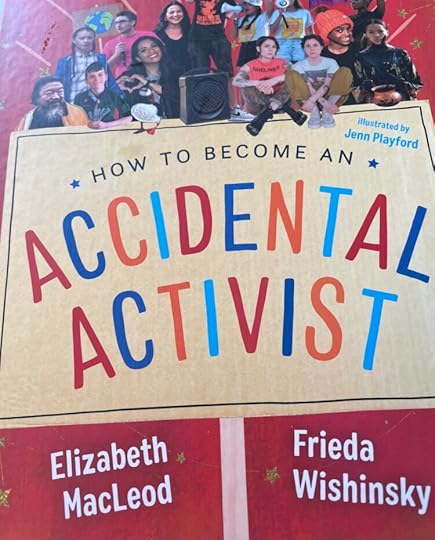 Welcome to Cantastic Authorpalooza, featuring posts by and about great Canadian children’s book creators! Today’s guest:
Frieda Wishinsky
. Take it away, Frieda!
Welcome to Cantastic Authorpalooza, featuring posts by and about great Canadian children’s book creators! Today’s guest:
Frieda Wishinsky
. Take it away, Frieda!
How to Become an Accidental Activist (Orca Books) is the sixth book I’ve written with Elizabeth MacLeod. It’s geared for kids and adults age 8 and up and focuses on a diverse group of women and men of all ages and backgrounds who’ve made a difference in the world.
Their perseverance inspired me. Nothing stopped them from advocating for human rights, keeping our planet green, preserving natural places and more.
But how do two people write a book together and why?
Liz and I don’t actually write together. We brainstorm ideas over lunch or cookies and tea and then divide the work on our proposal. When our proposal is accepted, we each write our own chapters and never edit each other’s work. We leave that to our editor. Magically our non-fiction voices are close enough that we sometimes forget who wrote what.
As for the why write with a partner— it’s fun to come up with a subject together, toss out ideas and still maintain our own “voice” and subjects. We usually choose a big topic, and it makes the task easier when it’s divided into two.
In How to Become an Accidental Activist I chose people like Joshua Wong, who valiantly fought to keep Hong Kong free of Chinese oppression. Unfortunately, the efforts of so many brave Hong Kong residents like Wong failed (for now) because of China’s immense military power.
I also profiled Maziar Bahari from Iran who continues to speak up against tyrannical regimes. When Maziar attended Montreal’s Concordia University one of his professors told the class about the discrimination Jews faced in the Holocaust. The story touched Maziar so much that soon after graduating, he made a film about the Voyage of the St. Louis, a ship filled with Jews escaping the horror of Hitler’s regime. The ship was turned back by Cuba, the US and Canada. Most of the people who were turned back, died in the Holocaust. As the child of a family who lost most of my family in the Holocaust Maziar’s courage to speak out and write about oppression inspired me.
Maziar called his memoir They Came for Me after the powerful words of Martin Niemoller, an outspoken critic of Hitler. Niemoller’s words ring true today. If we don’t speak out against tyranny and evil, it will escalate. As he says at the end of his free verse poem: “Then they came for—and there was no one left to speak for me.”
I also wrote about Liz Christy who started the first urban garden in New York City, where I grew up. I love green space. As a kid city parks were my refuge and playground. Christy not only understood how important greenspace is for everyone, she created greenspace when she gathered her friends, and together they turned an abandoned lot into an urban oasis for the neighborhood. Her urban garden idea has spread around the world.
Writing gives me the opportunity to write about people, places, and themes that I’m passionate about. I’m grateful when my words and ideas become a book and are shared with readers of all ages and often around the world.
May 27, 2022
Marina Cohen – The Seeds That Became Shadow Grave
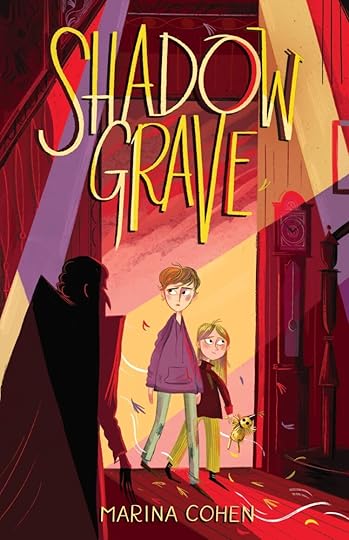 Welcome to Cantastic Authorpalooza, featuring posts by and about great Canadian children’s book creators! Today’s guest:
Marina Cohen
. Take it away, Marina!
Welcome to Cantastic Authorpalooza, featuring posts by and about great Canadian children’s book creators! Today’s guest:
Marina Cohen
. Take it away, Marina!
I began writing the first draft of this novel so long ago, its working title was Frozen. Well, we all know what happened to that title, thank you very much Disney! I’d go through several more titles before settling on Shadow Grave. Let me tell you a little about the inspirations for this novel.
Decades ago, I read Tuck Everlasting by Natalie Babbitt. This brilliant novel lives up to its title in so many ways as, once read, its story and characters remain with you forever. The novel gave me not only great pleasure but left me with large questions to ponder. And it was in my ponderings that the first seed of Shadow Grave was planted.
I love poetry. It’s a personal experience—one to which you bring your own feelings and interpretations. In Frost’s famous work, The Road Not Taken, did he intend there to be a right path, a better path? Most believe so, however, the way I see it, there is no right way and no wrong way. Life is an infinite series of choices that ultimately bring us to the same place: onward. And so, the second seed for my novel was sown.
Good writers write what they are passionate about. It’s only natural then, that as a writer of creepy stories, they are my passion. Growing up, I delighted in the works of Edgar Allen Poe, Mary Shelley, and H.P. Lovecraft’s stories. I was fascinated with Lovecraft’s Cthulhu mythos—the idea that there are things which lie beyond our human perception of reality. What did Lovecraft mean when he wrote That is not dead which can eternal lie…? This line would become an integral part of my story.
Of course, writers cannot sit around merely pondering life’s great mysteries. We must pay the bills, right? And so, while writing a work-for-hire non-fiction book on deserts, I came across this bizarrely cute, almost miraculous, and virtually indestructible little creature—the tardigrade. They can survive for decades without water or food. They can survive extreme temperatures, radiation, pressure equal to that of the deepest part of the ocean, and even the vacuum of space. Tardigrades will survive cataclysmic events that could wipe out most other species on this planet. Hmmm….yet another seed…
It would not be, however, until the fifth seed was planted in my imagination, all the shoots growing, intertwining, becoming one, that I’d be ready to write—and this seed was the town my novel is set in: Livermore. While engaging in one of my favourite pastimes— researching real-life ghost towns—I came across this gem of a place—its remnants still hidden in the White Mountains of New Hampshire.
Though little is left of the structures that were once a vibrant little logging town, it had a rich history—with one particularly creepy fact that made me sit bolt upright and I knew this was it. I was ready.
Though I have borrowed bits and pieces of the real town—its history, geography, a slightly altered name or two—Shadow Grave is wholly a work of fiction. Its inhabitants and the town are how I imagine them to have been—almost mythical.
I include much of this information in an Author’s Note—even an image of the real town of Livermore that was a definite inspiration.
I always say that great horror must satisfy beyond its capacity to scare—it must be a metaphor for the fears and horrors of everyday life. And so, what I did not include in my Author’s Note was the sixth and final seed—one I could not bear to write about at the time.
When my dear aunt was diagnosed with stage 4 cancer I was devastated. She was the last of my father’s side of the family—the teller of tales and the keeper of secrets. With no spouse or children, I was her closest family and I knew this would be a path she and I would walk together. Unfortunately, Cancer is no “road less travelled” to which all too many can attest, and for us, it was a painful path, filled with agonizing sorrow, and an utter sense of helplessness. When my aunt and I arrived at the crossroads, the point our paths would diverge, for now, I was forever changed. And this is what would become the emotional heart of my novel, the emotional journey of my 12-year-old character, Arlo.
I hope you’ll pick up a copy of Shadow Grave and find in it much more than a few chills and scares. It is my hope you’ll find in it a tiny seed you can ponder long after the last page is turned.
May 20, 2022
Patricia Storms: The Power of Short and Gentle
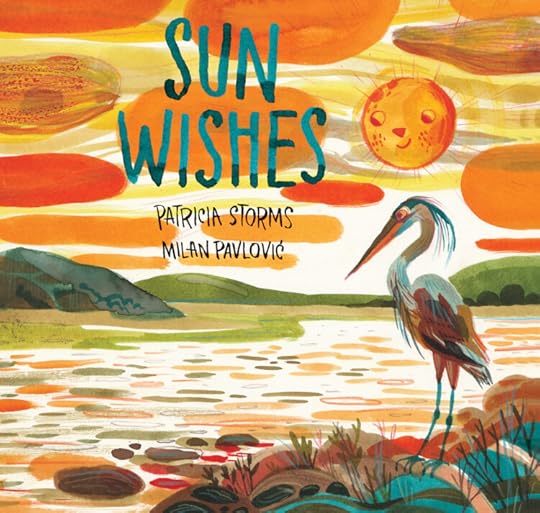 Welcome to Cantastic Authorpalooza, featuring posts by and about great Canadian children’s book creators! Today’s guest:
Patricia Storms
. Take it away, Patricia!
Welcome to Cantastic Authorpalooza, featuring posts by and about great Canadian children’s book creators! Today’s guest:
Patricia Storms
. Take it away, Patricia!
Every now and then, as a picture book author/illustrator, I do the one thing that I know I should not do. I’m in a good mood, I’m feeling upbeat about my career, and the world is a cheerful, friendly place. And then… I go and read some of my book reviews.
Why do I do this? Because, on some level, I still need some sort of outside affirmation? More than likely yes. So comments like: “I like the art style better than the text” aren’t going to help me. Neither is “quick, short, unremarkable”, or “very short, undeveloped picture book.” Ugh. Yes, yes, I know – I keep breaking the one big golden rule in this biz – stay away from negative reviews!
The thing is, I love creating stories with very limited text. I’ve always been this way, ever since I can remember. My kindergarten report card stated: “Her stories, though brief, are very imaginative.” So yes, I’m very conservative in my word count, but I like to think that I pack a healthy creative punch with my chosen words. And I do choose my words very carefully, for any kind of writing – be it poetry, a one-panel gag cartoon, text for a greeting card, and yes, when I write text for a picture book. It’s a delightful feeling to let my mind wander around, picking and tossing out words until I find the perfect way to express a thought or an emotion. I’ve compared the editing of text to weeding in a garden – sometimes you gotta let certain things die in order to allow other things to flourish and blossom. All 142 words in my most recent picture book, Sun Wishes, matter. I invited them in my story with the same care I would use in choosing a good friend.
So no, I’m not going to stop writing soft, short picture books. I will have to continue to hope that my stories go into the hands of people who need that gentle approach to storytelling, along with the love of that perfectly chosen, beautiful word.
Patricia Storms is an author and illustrator of over 30 children’s books and humour books, including The Pirate and the Penguin and Never Let You Go. Her most recent authored books are The Dog’s Gardener, illustrated by Nathalie Dion, and Sun Wishes, illustrated by Milan Pavlovic, both books by Groundwood Books. She lives and works in Toronto with her husband Guy, in a house overflowing with books and art.

